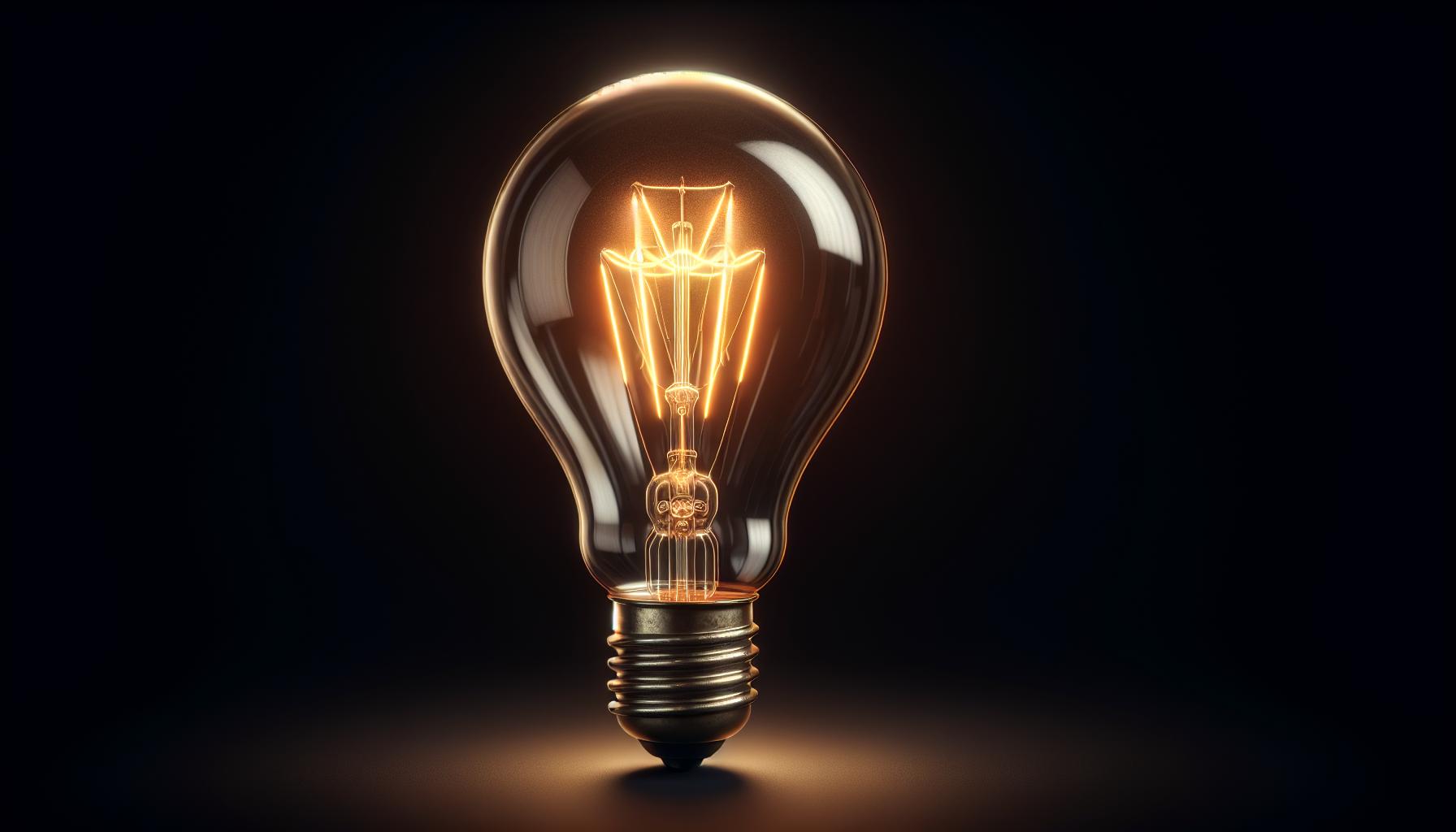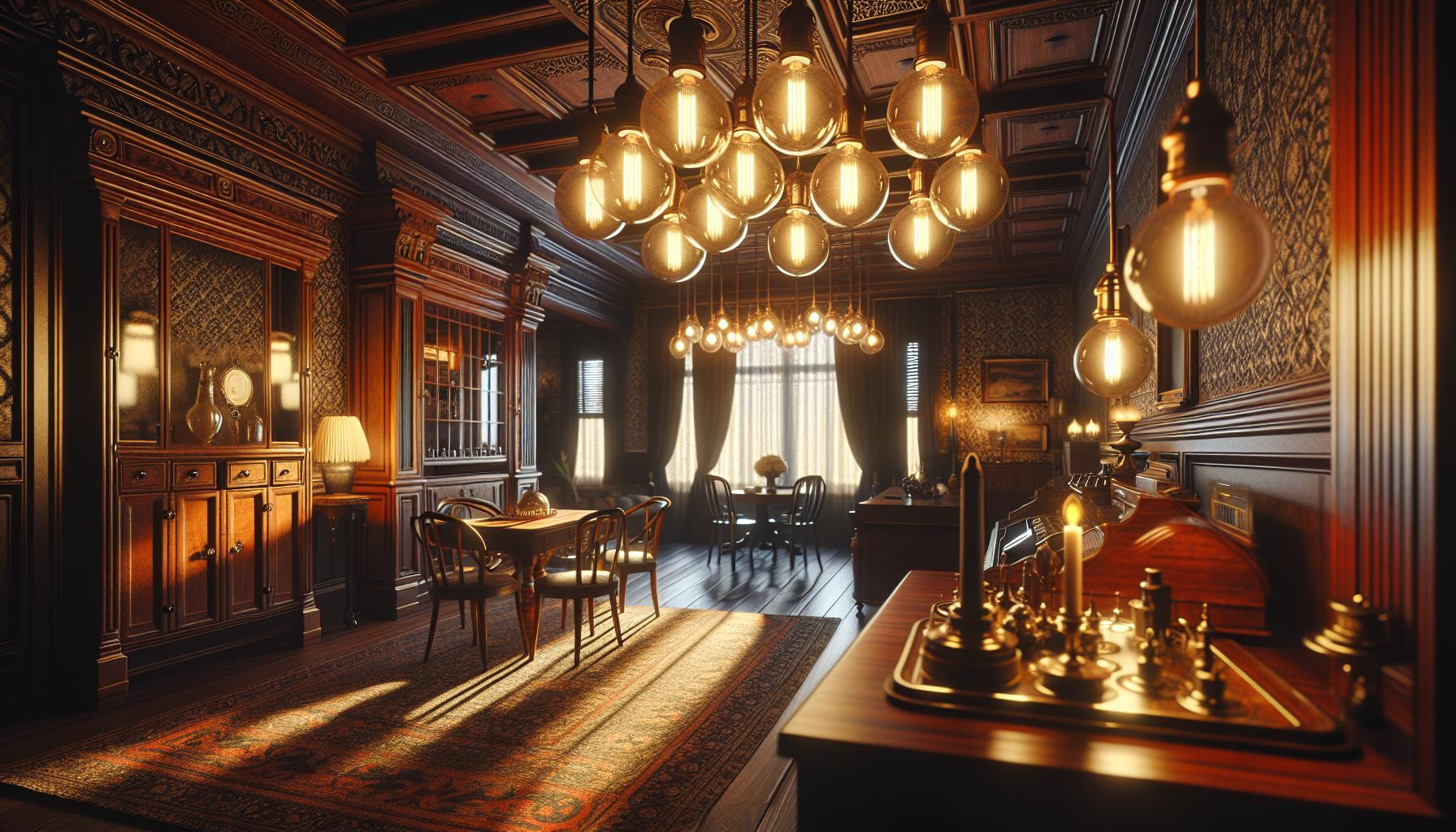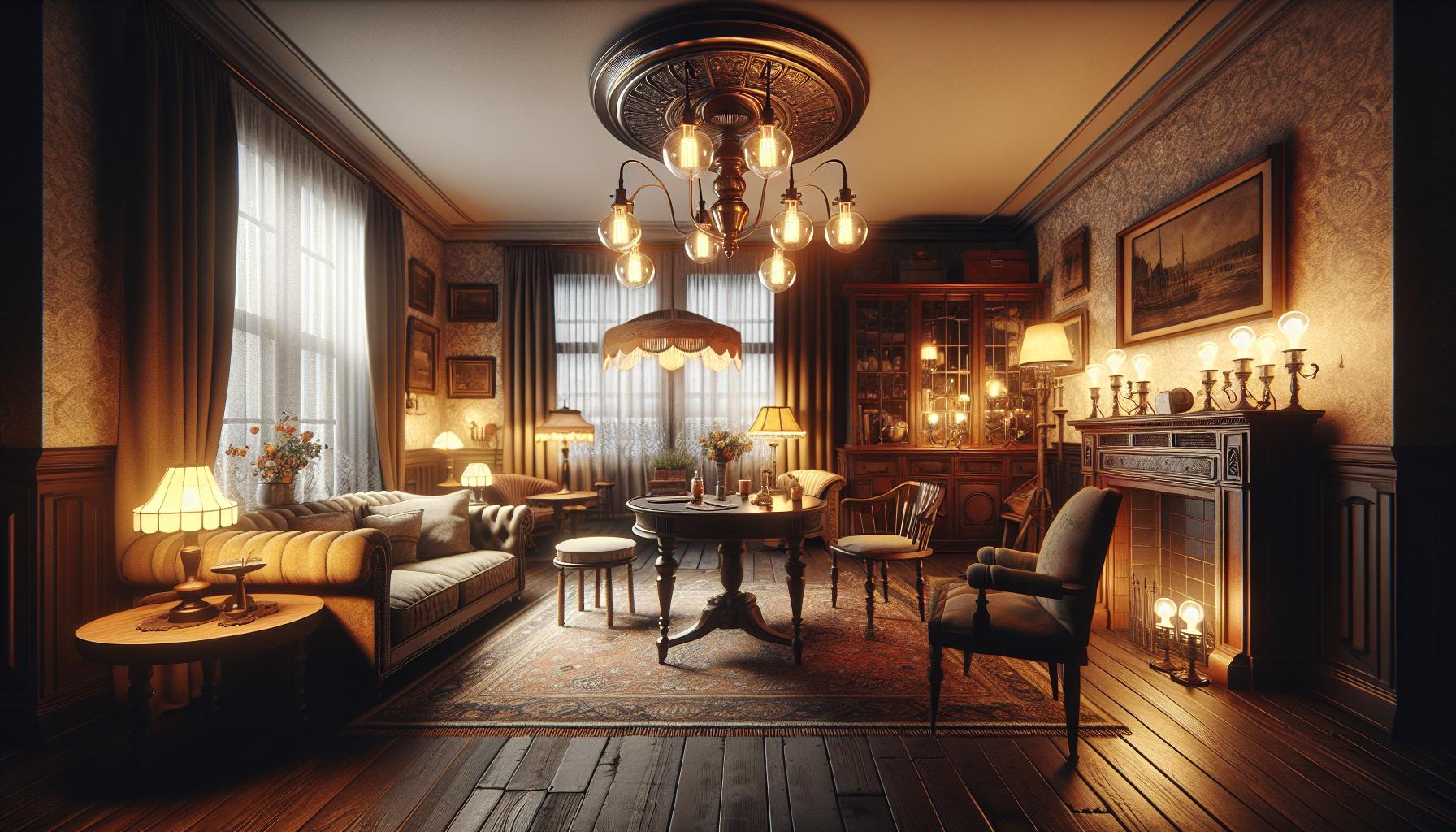Imagine life without the flip of a switch to instantly brighten your room. Hard to picture, right? But there was a time when electric light bulbs were a novelty, not the staple they are today.
It wasn’t until the late 19th century that the incandescent light bulb began to make its way into homes. The journey from luxury to a household essential is a fascinating tale of innovation and accessibility.
You’ll be surprised to learn just how recent the widespread use of light bulbs in homes actually is. Let’s delve into the illuminating history of how these bright ideas became fixtures in our daily lives.
Early attempts at artificial lighting
Before you could flip a switch and brighten your whole room, the quest for artificial lighting took on many forms. You might find it hard to imagine a world lit only by flickering candles and oil lamps, and yet, for centuries, that was the norm. Candles, made from tallow or beeswax, were the primary light sources, burning brightly but leaving soot and smoke in their wake.
Oil lamps were another early lighting method, using a variety of oils like whale or sesame. However, these too had their downsides, from the ever-present fire hazard to the pungent smells. It wasn’t until the 19th century that artificial lighting solutions began resembling what you might recognize as a precursor to modern electric bulbs.
- Gas lighting emerged as one of the first widely adopted forms of artificial lighting, without the need for candles or oil. This was a game changer for street lighting and slowly made its way into homes of the well-to-do.
Imagine the joy of being able to light your entire home without moving from room to room lighting individual candles. It must’ve felt like the ultimate luxury, even if the gaslights did pose their own set of challenges, such as complex installation and the potential for gas leaks.
- Then came the arc lamp, dazzling crowds with its bright light, ideally suited for large spaces and outdoor areas. But for the typical home, the arc lamp was overkill—too bright, too large, and far too dangerous.
As a DIY enthusiast and light-lover, you’d probably appreciate the ingenuity behind these earlier forms of lighting, but also see why they wouldn’t fit in today’s homes. Each step in the evolution of lighting solved a problem of its time, pushing the boundaries of what was possible and setting the stage for the next great innovation – the electric light bulb.
The invention of the incandescent light bulb
In the grand tale of lighting, the leap to the incandescent light bulb is nothing short of revolutionary. Your home DIY projects and love for lighting all point back to this pivotal moment. Picture yourself in the late 19th century when inventors were racing to create a reliable and safe light source for everyday use. Among them, Thomas Edison stands out—not because he was the first, but because he developed a practical and long-lasting bulb.
Edison’s bulb, patented in 1879, was a game-changer. It used a carbonized filament inside a vacuum, which glowed when electrical current passed through it without catching fire or burning out quickly. This wasn’t just a flash in the pan; Edison’s design stayed lit for hours on end.
Boldly imagine the moment Edison’s bulb first illuminated a room: the soft, steady glow casting shadows away, revealing a world of possibilities. This wasn’t just a source of light; it was the beacon of an industrial revolution.
Key Dates in Light Bulb Adoption:
| Year | Milestone |
|---|---|
| 1879 | Edison patents his incandescent bulb |
| 1880s | Bulbs become commercially available |
| 1890s | Widespread use in urban homes begins |
While Edison’s bulbs began weaving their way into homes during the 1880s, it wasn’t until the turn of the century that electric lighting became a staple, particularly in urban areas. Infrastructure had to catch up, with power stations and electrical grids needed to bring this modern marvel into homes.
Your passion for lighting finds its roots here. Each bulb in your home is a descendant of Edison’s vision, refined over the years. Today’s bulbs are more efficient and longer-lasting, thanks to LED and CFL technologies, but they owe their lineage to the humble incandescent. As you screw in a bulb or flick a switch, you’re part of a legacy that transforms night into day, one that continues to evolve with each bright idea.
Challenges in making the light bulb accessible for homes
« Which Light Bulb Is Most Efficient? Unveil the Top Energy Savers
How Often to Change Car Light Bulbs: Stay Safe with These Tips »
While the invention of the incandescent light bulb by Thomas Edison was a watershed moment, making it accessible and commonplace in homes was no small feat. Let’s shed some light on the hurdles that had to be overcome.
Early light bulbs were prohibitively expensive, a luxury beyond the reach of an average household. Consider that when Edison first introduced his bulb, the cost was steep, factoring in not just the bulb but also the electrical infrastructure needed to power it. Even in 1900, a single light bulb could cost as much as $2 – equivalent to about $60 today.
Aside from the cost barrier, infrastructural challenges abounded. Extensive wiring had to be put in place, a grid capable of providing consistent electrical power. Initially, urban areas were the primary focus due to their higher population density, which left rural areas quite literally in the dark for years to come.
Another hurdle was safety concerns. Stories of electrical fires and unsafe installations made potential customers wary. Education around the safe use of electricity and improvements in electrical standards were necessary to quell these fears.
Even the bulbs themselves needed refinement. Edison’s bulbs lasted just 1500 hours—a significant improvement over predecessors, but far from the longevity we expect today. Innovations in materials and design were required to enhance the durability of these bulbs and make them a practical choice for daily use.
As bulbs improved and prices fell, marketing campaigns played an essential role. Companies like General Electric worked hard to dispel myths and highlight the benefits of electric lighting, gradually making it an object of desire for the typical consumer.
Throughout these struggles, persistence and innovation helped to overcome each barrier, turning the light bulb from a novelty into a necessity. With each passing year, light bulbs became more efficient, affordable, and integral to home life, paving the way for the bright, illuminated spaces you’re accustomed to now.
The rise of electric companies and the spread of electricity
As you delve into the transformation of home lighting, you can’t overlook the crucial role that electric companies played. In the late 19th and early 20th centuries, electricity was not as ubiquitous as it is today, and the spread of electrical infrastructure was key to making light bulbs common in homes.
Initially, electricity was generated by small, local power stations, but it wasn’t long before demand led to the growth of larger electric companies. These companies built power plants, extended power lines, and laid a vast network of wiring to reach more customers.
As these networks expanded, the price of electrifying a home dropped significantly. This was a game-changer. Now, even middle-class families could dream of flicking a switch to illuminate their homes.
Let’s look at some pivotal developments:
- Centralized Power Distribution: This innovation allowed for more efficient and widespread electricity usage.
- Municipal Contracts: Electric companies often secured exclusive contracts to provide power to entire cities, which sped up the electrification process.
The economic boom of the Roaring Twenties also contributed to the spread of electricity. With more disposable income, families invested in the modern convenience of electric lights, among other electrical appliances. Electric companies seized the moment, offering attractive deals and financing options to homeowners keen on updating their living spaces.
These advancements weren’t just about lighting – they marked a shift in the American lifestyle. Electricity began to symbolize progress and modernity, and the light bulb was its shining icon. Households embraced the comfort and convenience of electric lighting, and the demand for durable, affordable light bulbs soared.
The proliferation of electricity thereby turned what was once a luxury into a standard fixture in homes. It changed daily routines, extended productive hours after sunset, and you’ll find it sparked a revolution in home DIY projects and interior design.
The impact of widespread electrification on home lighting
Widespread electrification was like a spark that ignited a revolution in home lighting. Before the 20th century, the concept of flipping a switch to illuminate your entire house was pure fantasy. But as electricity started to snake its way through cities and eventually into rural areas, the reality of electric lighting became as tangible as the light bulbs themselves.
This pervasive shift meant that the once-dominant kerosene lamps and gas lights were gradually replaced. Electric lighting didn’t just simplify life; it transformed daily routines. Suddenly, you could do more than just extend the day—you could dictate it. You could engage in late-night DIY projects or admire your newly installed fixtures any time you wished.
As more households were wired up, the electric grid matured, and with that, the reliability of home lighting improved drastically. Outages were less frequent, and the incandescent bulbs gleaming from living rooms became symbols of the age—icons of reliability and consistency. The cost, too, was impressive; economies of scale worked their magic and the expense of lighting a home plummeted.
Think about it: you could now light your home without a thought for the gas supply or the mess of oil lamps. It was newfound freedom, a liberation from the constraints of older lighting methods. This change echoed throughout home design as well, with architects freely incorporating electric lighting into their visions without the limitations of gas or oil fixtures.
Here’s a glimpse of how costs fell:
| Year | Cost of Electricity (Per kWh) |
|---|---|
| 1920 | $0.17 |
| 1930 | $0.10 |
| 1940 | $0.09 |
Note: Prices are adjusted to 2020 dollars.
Electricity’s domino effect didn’t end with just lighting. It energized an entire wave of domestic appliances, forever altering the pace and possibilities of life at home. The availability of different types of light bulbs meant that you could personalize your spaces, set moods, and design your home not just for function but for feeling and ambiance—an electrician’s dream that you, too, could experience without leaving your doorstep.
Conclusion
You’ve seen how the humble light bulb sparked a revolution in your home, transforming the night into day at the flick of a switch. It’s fascinating to think about the journey from kerosene lamps to the dazzling array of lighting options you have today. Now you can set the mood, focus on work, or brighten up a party with ease. Remember, every time you flip that switch, you’re part of a history that lit up the world and changed the way you live, work, and play. Keep shining bright!
Frequently Asked Questions
What did electricity replace in home lighting?
Electricity replaced kerosene lamps and gas lights, bringing a transformative change to home lighting by providing greater freedom and flexibility.
How did electrification impact daily routines?
The introduction of electricity into home lighting significantly altered daily routines, allowing for extended activities into the evening hours and enhancing overall convenience and safety.
Has the reliability of home lighting improved over time?
Yes, as the electric grid matured, the reliability of home lighting has substantially improved, ensuring consistent and continuous illumination in homes.
What happened to the cost of lighting a home with the advent of electricity?
With the widespread adoption of electricity, the cost of lighting a home has notably decreased over time.
What are some secondary effects of home electrification?
Electrification led to the creation of various domestic appliances and granted homeowners the ability to personalize their spaces with different types of light bulbs.




